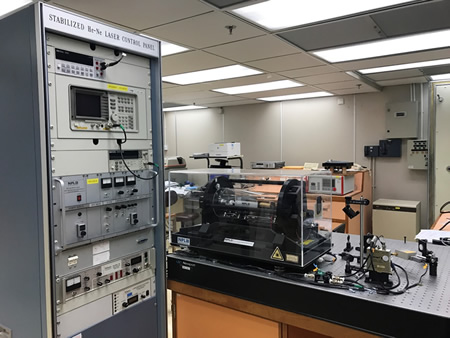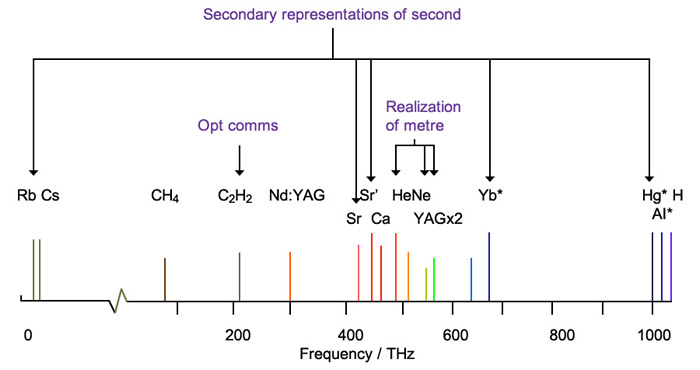Iodine Stabilized Helium-Neon Laser
Primary Standard for Realization of the metre– iodine stabilized helium-neon laser
 Photo of the SCL iodine stabilized HeNe laser
Photo of the SCL iodine stabilized HeNe laser
The practical realization ("Mise en pratique") of the definition of the metre, published by the CIPM in 1983, included the following methods:
- length l travelled in vacuum by a plane electromagnetic wave in a time t, using l = c0⋅t and c0 = 299 792 458 m s–1,
- wavelength in vacuum of a plane electromagnetic wave of frequency ƒ, using λ = c0/ƒ and c0 = 299 792 458 m s–1,
- by means of one of the radiations from a list, which is summarized in the graph below.
 Secondary Representations of Second
Secondary Representations of Second
The Consultative Committee of Length – Consultative Committee of Time and Frequency (CCL-CCTF) Frequency Standards Working Group is in charge of producing and maintaining the list of Recommended values of standard frequencies for application including the practical realization of the metre. Among the recommended frequencies, SCL has chosen 473.612 THz, corresponding to a wavelength of 633 nm, generated by an Iodine stabilized Helium-Neon Laser as its method of practical realization of the metre.
The 633 nm Iodine stabilized Helium-Neon Laser was the most classical standard frequency. Long before the last major change in the definition of metre that related the metre with the speed of light in 1983, Helium Neon laser was already one of the most popular research topics in the frequency metrology. Knowledge and techniques like the stabilization using iodine cell, 3rd derivative locking, saturated spectroscopy, etc. were developed in maintaining a high accuracy and stability of the frequency. Until the development of the frequency comb in around 2000, inter-laboratory comparison was developed by checking the beat frequency between different hyperfine components of the 633 nm laser frequency. For this historical reason, 633 nm frequency laser was used in many national metrology institutes (NMIs) as the practical realization of the metre.
To fulfil the requirement for the practical realization, the following conditions must be matched
- cell-wall temperature (25 ± 5)°C;
- cold-finger temperature (15.0 ± 0.2)°C;
- frequency modulation width, peak-to-peak, (6.0 ± 0.3)MHz;
- one-way intracavity beam power (10 ± 5) mW for an absolute value of the power shift coefficient ≤ 1.0kHz/mW.
With the above conditions and other necessary condition on the optical and electronic control systems including the use of the third harmonic detection technique and corresponding to the ƒ hyperfine component, the following values
ƒ = 473 612 353 604kHz
λ = 632 991 212.58 fm
with a relative standard uncertainty of 2.1 x 10-11 can be used.
Reference